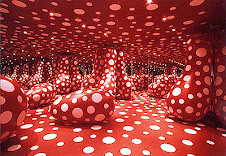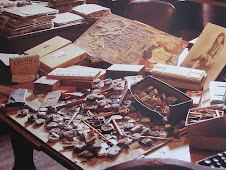
Tuesday, November 27, 2007
Post for Final Presentation 2


There are a few different artist I specifically want to mention during my presentation that are the most engrossing. I think I am drawn to them because of the exasperation of mark making, their obsessive use of a chosen form ---what does this reveal about them autobiographically? Yayoi Kusama, Agnes Martin Liza Lou are the quintessential examples of expressing their impulse through the visual arts. I have also asked a few of the studio art professors their opinions on this subject matter and if at all they can relate/attempt to help my better understanding of this subject.
Yayoi Kusama for example since the age of ten has continually covered her environment with polka dots. She has created elaborate costume and performance in order to physically display her work---she is the work at times. From wikipedia synopsis what her name brings: [Yayoi Kusama (草間彌生 or 草間弥生, born March 29, 1929) is a Japanese artist. Her paintings, collages, soft sculptures, performance art and environmental installations all share an obsession with repetition, pattern, and accumulation. Her work shows some attributes of feminism, minimalism, surrealism, Art Brut, pop art, and abstract expressionism, and is infused with autobiographical, psychological, and sexual content. She describes herself as an "obsessive artist". Kusama is also a published novelist and poet, and has created notable work in film and fashion design. She has long struggled with mental illness.] I posted a few pictures on my blog but please visit her website she is truly a phenomenon
Liza Lou (California based artist) on the other hand --instead of uses beads inorder to create her mark. Sometimes working 18 hours a day in order to cover only five inches of space. (See Pictures above). In order for her to create these beaded environments she must sell less complicated smaller versions. She sells these only to make enough money to buy more beads so the process can continue and is in an endless cycle.
Agnes Martin a Canadian artist makes minimal graphite marks repetitively mostly on paper in more of a Taoist fashion.
Why are these three artist so different in their choice of marks and where has this impulse sprung from---what sort of autobiographical satisfaction can they gain? Is it possible to every be satisfied---is their work ever done or their 'voice' ever truly understood by the audience?
I will post the questions I presented to the facutly in my next blog
Post 1 For Final Presentation
My current studies/title is Master of Fine Arts Candidate with an emphasis in Ceramics and a minor in printmaking. This is the first semester of my second year. I have been given a studio and am expected at the end of every semester to have produced a substantial body of work. I am to present and 'defend' this work in front of a review committee which consists of the entire studio art faculty. This is meant to demonstrate a continuation of the previous semesters work as well as a display a further challenge and investigation/understanding of the medium at hand. Although I partake in a substantial amount of clay work ----this semester I have been formulating different casting slip bodies going to cone 10 (2435 degrees F), learning how to load and operate an atmospheric kiln, as well as incorporating my printmaking with ceramic work cohesively. Simultaneously I feel the ‘impulse’ to draw and paint as I have always felt compelled since youth.
Now why am I telling you all this?
I think this information will provide the class with a back drop for this research. I think that my choice of topic for this final presentation reveals a bit about me---autobiographically speaking.
My topic overview:
In my talk I want to discuss the Autobiographical Impulse in terms of mark making in visual arts----The repetitive almost compulsive way in which some visual artist manifest themselves through the action of decorative motif on surface. Because of my own methodologies and work process I feel compelled and interested in this subject matter and think that much of our in class discussions and text is applicable in researching and understanding this topic.
Now why am I telling you all this?
I think this information will provide the class with a back drop for this research. I think that my choice of topic for this final presentation reveals a bit about me---autobiographically speaking.
My topic overview:
In my talk I want to discuss the Autobiographical Impulse in terms of mark making in visual arts----The repetitive almost compulsive way in which some visual artist manifest themselves through the action of decorative motif on surface. Because of my own methodologies and work process I feel compelled and interested in this subject matter and think that much of our in class discussions and text is applicable in researching and understanding this topic.
Reaction to Bell and Gemmell ----Flickrverse
I like the idea of using digital memory and the technologies surrounding this topic as a way of bettering our medical care. The discussion of being able to catch a disease early by constant evaluation of caloric output, body temperature, pulse ecetra---this is a completely new idea to me. As far as using these sorts of technologies to record a persons constant move as in the case of this 'Digital Diary' seems a bit compulsive... I think that could be an extremely dangerous power that could be used to the advantage of certain people or groups of ppl . As far as how this article pertains to the flickrverse 2005 this is a definate way to grid and record correspondance between many people where as the article seems to be discussing digitally documenting a singular persons interactions. I wonder what sort of software was used in this flickrverse---does the creator of it have an intention for it to be viewed as a piece of art or was it merely to document the practices of flickr users?
Tuesday, November 20, 2007
reaction to Rose
After reading the rest of the classes reaction to Rose---I feel a bit disoriented within the text I seem to have gathered quite a different perspective from the it. Seems a bit like he's writing some sort of motivational speech or self-help dialogue. I will be a better judge after our discussion in class regarding this work.
Thursday, November 15, 2007
Reaction to Vollmer's 'Reading the Water"
It is ingenius the way in which Vollmer uses layering to project meaning---not only with sound but as well with text. The beginning dialogue imposes all three male Vollmers although they are not all in the shot. It seems as though there is a constant stream of these three subjects being present in some way. Although it appears firstly that Niklas has taken it upon himself to show his young son Tannus the coastline of Maine---I think in reality his true intentions are to relive his own cildhood and carry on a dialogue with his aging father. It is interesting that while Vollmer senior is partaking in what he knows best being an ecologist/biologist---Niklas VOllmer is in the role of his profession as cinematographer shows them with this sort of barrier of professionalism. While the young son creates a playful layer does Niklas Vollmer use his son's presence in the film as a way in which to communicate with his own father on a more intimate layer as well with text 'where are you going daddy?' "are you okay?" "don't leave" etc. The shots of water itself algae covered---opaque/rippling behind a motorboat, transparent in a calm marsh.....what sorts of connotations do these shots hold? Has the study of this coastline created an ecology between these three generations?
Monday, November 12, 2007
reaction to Family Secrets
during this analysis of the family Album Kuhn brings up many aspects of the photograph and its relation to the famil unit I would have never before pondered. She says that family pics are in fact what creates a culture within that unit. Like Barthes snipets she discusses the captions written by her mother in the margins of the album. Mentions memory as being a type of archeology that is extracted, investigated, ecetera. There are those who produce and those who comment on the production. The discussion of the character 'Mandy' was a bit difficult for me to follow---and how it tied into the essasy itself . I relate this author's use and understanding of the picture as correlating hugely with Barthes. Although I think she consider's the punctum in the snipet/caption rather than the imagery itself.
Wednesday, November 7, 2007
Reaction to Derrida--- Along with questions to consider for tomorrows presentation
There seems to arise a great deal of questions from Derrida's text rather than any blatant answers. Firstly he references the human ear as a way to decipher literary works specifically Nietzsche's own auto biography 'Ecce Homo'. Nietzsche makes it clear that he signs his work posthumously, meaning that it is only done after it is read. The ear relays the information and 'speaks' it to the reader.
Does this mean there can be no real control for the author? Is the reader the only one who can decipher and project their own views upon the writing?
There is a political nature within the text how does this effect a society or a culture?
What is Derrida suggesting by this social power displacement?
Can a Signature change over time? Example Person A. reads Ecce Homo if it is read a second time by Person A. how much if at all will Nietzsche's posthumous signature change?
What determines the size of the ear ? What has created these determining factors?
What sorts of responsibilities does the reader have----any ownership?
Can this theory be used in context of any medium?
Does this mean there can be no real control for the author? Is the reader the only one who can decipher and project their own views upon the writing?
There is a political nature within the text how does this effect a society or a culture?
What is Derrida suggesting by this social power displacement?
Can a Signature change over time? Example Person A. reads Ecce Homo if it is read a second time by Person A. how much if at all will Nietzsche's posthumous signature change?
What determines the size of the ear ? What has created these determining factors?
What sorts of responsibilities does the reader have----any ownership?
Can this theory be used in context of any medium?
Tuesday, November 6, 2007
reaction to Autobiography as Defacement
Found it interesting his reliance on Wordsworth. The first section that really stood out to me was on page 921 " Autobiography, then, is not a genre or a mose, but a figure of reading or of understanding that occurs, to some degree, in all texts." I see this as having a very liberal meaning. So could it be considered that a 'want ad' or a 'to do list' is in some respects self-reflective? According to De Man it appears to be his opinion that in fact these items are in fact auto-biographical. Noticed his use of the words 'genre' and 'generic' atleast three times within 921-920 to describe autobiography we have discussions during class about the underlying meaning of these words.
The last sentence of this piece
"Autobiography veils a defacement of the mind of which it is itself the cause"
I wonder how Franklin, Rousseau, or St. Augustine would handle that opinion.
The last sentence of this piece
"Autobiography veils a defacement of the mind of which it is itself the cause"
I wonder how Franklin, Rousseau, or St. Augustine would handle that opinion.
Subscribe to:
Posts (Atom)



